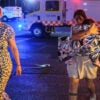When al-Shabab withdrew its frontline forces from Mogadishu last August, the terrorist group vowed to launch a wave of asymmetric attacks against the Transitional Federal Government (TFG) and the African Union’s Mission in Somalia (AMISOM). On Tuesday morning, an al-Shabab suicide bomber attacked the Ministry of Education, killing 70 and wounding dozens. Among the casualties were young students waiting for notification on their acceptance for a scholarship in Turkey.
Though al-Shabab targets primarily AMISOM troops and TFG officials, the group has been known to launch attacks against Somalia’s academic community and educated elite. In December 2009, a suicide bomber attacked a university graduation ceremony in Mogadishu, killing 23, including government ministers, medical students, and doctors. Three months prior to the attack, al-Shabab warned the Ministry of Education about its use of “un-Islamic” textbooks. Al-Shabab’s educational methods range from awarding children fully automatic assault rifles and live hand grenades for their knowledge on al-Shabab trivia, to outlawing bells in schools because they sound too similar to church bells. According to al-Shabab’s deputy commander in chief, Shiekh Mukhtar Robow, “Youths should use one hand for education and the other for a gun to defend Islam.”
Al-Shabab’s close affiliation with al-Qaeda has made its fighters more sophisticated in their use of guerilla tactics including suicide attacks and the use of improvised explosive devices (IEDs). Many of al-Shabab’s top leaders have trained and conducted operations with al-Qaeda in Afghanistan and have applied such experiences to Somalia. Al-Shabab has also imported al-Qaeda’s public messaging skills. Immediately following today’s attack, al-Shabab took responsibility on its website. Al-Qaeda has publicly reached out to al-Shabab, acknowledging its support for operations in and outside Somalia. Recently deceased al-Qaeda in the Arabian Peninsula (AQAP) leader Anwar al-Awlaki captured a wide Internet audience and used online forums to engage with al-Shabab members and encourage his audience to financially support its operations.
AMISOM and the TFG should not treat al-Shabab’s August withdrawal from Mogadishu as victory. Rather, they should have taken advantage of al-Shabab’s absence and improved their capacity. Al-Shabab has switched strategies in Mogadishu, transitioning from an occupying force to one based on guerilla warfare. Al-Shabab will continue to expand its efforts to destabilize AMISOM forces by applying its strengths to AMISOM’s weaknesses. Although AMISOM has improved its capabilities within the past year, al-Shabab is a flexible organization that can easily adapt to challenges with limited resources. To prevent al-Shabab’s reoccupation of Mogadishu, AMISOM must do more to minimize potential threats by expanding its presence throughout the city and taking aggressive action to counter al-Shabab’s evolving terrorism strategy.






























